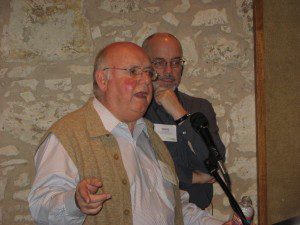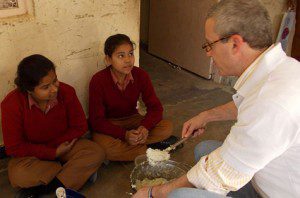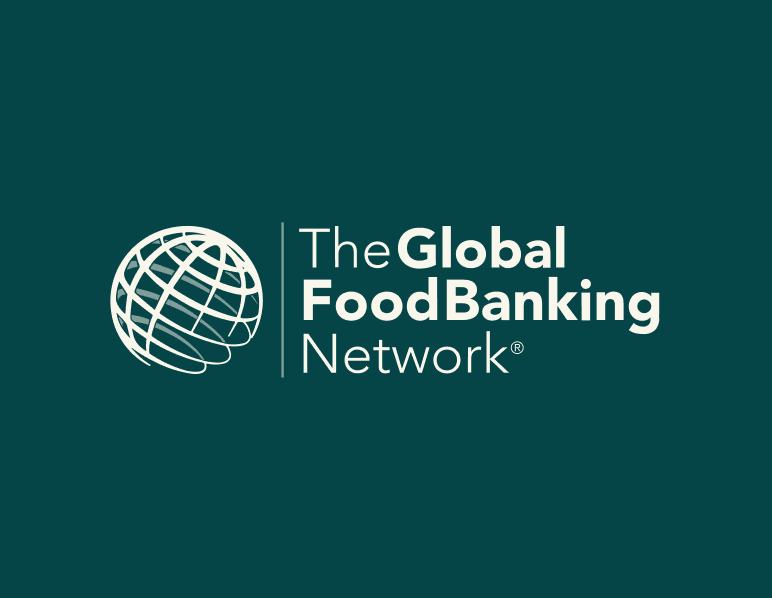2005년 8월 25일이었습니다. 미국, 캐나다, 멕시코의 푸드뱅크 리더 그룹이 모여 전 세계적으로 푸드뱅크에 대한 수요가 증가하는 것을 어떻게 해결할지 결정했습니다. 그들은 전 세계적으로 푸드뱅크를 만들고 지원하기 위한 새로운 국제 기구를 설립하기로 결정했습니다.
그들은 글로벌 푸드뱅킹 네트워크(GFN)라는 이름을 내놓고 바로 조직을 구성해 작년에 34개국에서 752개의 푸드뱅크로 구성된 번영하는 네트워크가 650만 명 이상에게 음식을 제공하도록 도왔습니다.
GFN의 수석 부사장인 크리스 렙스톡은 고인이 된 밥 포니와 빌 러드닉이 GFN을 만들 때 거기에 있었습니다. 그들은 모두 10년 전 8월 회의에 참석했습니다. 크리스는 당시 America's Second Harvest(현재 Feeding America)의 프로그램 부사장이었습니다. 그는 이 중요한 날로 이어진 사건을 기억합니다…
Chris Rebstock, GFN 임시 사장 겸 CEO 및 네트워크 개발 부문 수석 부사장
여러분은 Three Musketeers에 대해 알고 있을 가능성이 높지만, 그들이 GFN과 무슨 관련이 있는지는 모를 수도 있습니다. 그 연결은 저의 친구이자 멘토인 고인이 된 Bob Forney에게서 나왔습니다. 이 세기의 첫 10년 동안 Bob은 미국과 전 세계에서 푸드 뱅킹을 홍보하는 데 영감을 주는 리더였습니다. Bob은 푸드 뱅크가 확산되려면 네트워크가 Three Musketeers의 모토인 "모두는 하나를 위해, 하나는 모두를 위해"를 고수해야 한다고 종종 상기시켰습니다.
밥은 성공과 실패를 포함한 경험을 공유하는 것이 역동적이고 지속 가능한 푸드 뱅크 네트워크의 토대라고 믿었습니다. 따라서 GFN이 한 국가의 푸드 뱅크를 돕는다면, 그 국가는 우리에게서 배운 것을 공유할 도덕적 의무가 있습니다. 우리 모두가 공유한다면, 우리는 전 세계에 푸드 뱅킹을 퍼뜨리고 수백만 명의 도움이 필요한 사람들을 도울 수 있을 것입니다.

1990년대 후반, 저는 America's Second Harvest(현 Feeding America)에서 네트워크 서비스 팀을 이끌며 미국 전역의 푸드뱅크를 지원하고 있었습니다.
푸드 뱅킹은 북미에서 입증되고 성숙하며 성공적인 개념이었습니다. 푸드 뱅크는 미국에서 캐나다와 멕시코로 퍼져 나갔으며, 국가 네트워크가 해당 국가에서 활동을 조정했습니다. 미국 푸드 뱅킹의 창립자이자 아버지인 존 밴 헨겔은 푸드 뱅킹을 국제적으로 확산하는 데 도움이 되는 컨설팅 기관을 시작했습니다.
화제가 되고 있었고, America's Second Harvest에서 우리는 그 중심에 있었습니다. 다른 나라에서 푸드뱅크를 시작하고 싶어하는 사람들의 요청이 1980년대에 들어오기 시작했고, 문의 빈도와 심각성이 빠르게 증가했습니다. 우리의 초점은 엄격하게 국내에 있었지만, 우리는 우리가 가진 자원을 공유했습니다.
2000년 후반 어느 날, 아르헨티나에서 온 신부가 예상치 못하게 우리 사무실에 들러 부에노스 아이레스에서 푸드뱅크를 시작하는 것에 대한 조언을 구했습니다. 우리는 오랜 시간 이야기를 나누었고, 저는 그에게 집으로 가져갈 재료가 가득 담긴 상자를 주었습니다. 그는 작별 인사로 이렇게 요청했습니다. "푸드뱅크를 만들 때 글로벌 기업들이 우리가 America's Second Harvest의 엄격한 운영 기준을 충족한다는 것을 알 수 있도록 인증을 해 주시겠습니까? 그러면 우리가 신뢰를 얻고 그들의 지원을 동기부여하는 데 도움이 될 것입니다."
물론 America's Second Harvest는 미국 식품 은행만 인증했습니다... 하지만 그의 논리는 타당했기 때문에 저는 동의했습니다. 솔직히 말해서, 저는 그 이니셔티브가 성공할 것이라고 기대하지 않았습니다. 하지만 우리는 계속해서 연락을 유지했고 그들이 식품 은행을 시작하는 데 도움이 되는 조언을 제공할 수 있었습니다. 약 1년 후, 그들은 인증 방문을 할 준비가 되었다고 말했습니다.
이제 Bob Forney가 우리 CEO가 되었습니다. 이 시점에서 미국에서 지칠 줄 모르는 굶주림 투사이자 지역 푸드뱅크 수준과 국가 네트워크 수준에서 거버넌스에 대한 입증된 경험을 가진 Bill Rudnick이 이사회에서 근무했습니다.
밥의 축복과 1년 전 약속대로 저는 아르헨티나로 갔습니다. 지역 계획 팀과 푸드뱅크 직원들은 원격 지원 덕분에 놀라운 일을 해냈고, 푸드뱅크는 인증을 위한 모든 요건을 충족했습니다. 2004년에 그들은 7개의 푸드뱅크를 더 시작했기 때문에 다시 오라고 했고, 국가 푸드뱅크 네트워크를 시작하는 데 도움이 필요했습니다. 그래서 저는 이번에는 2주 동안 돌아갔습니다. 여행 중에 저는 여러 푸드뱅크를 더 방문하여 운영과 행정에 대한 조언을 제공하고, 푸드뱅크의 아르헨티나적 맥락에 대해 더 많이 알아보았습니다. 모든 푸드뱅크의 직원과 이사회 리더십이 3일간의 회의에 모여 전국적으로 푸드뱅크의 확장을 조정하고 지원하기 위한 국가 조직의 설립, 역할 및 권한 부여에 대해 합의했습니다.

아르헨티나에 발을 들인 것과 거의 같은 시기에 우리는 캐나다와 멕시코의 푸드뱅크 리더들과 북미 지역 푸드뱅크 네트워크를 만드는 것에 대해 논의를 시작했습니다. 우리가 노트를 비교했을 때, 우리는 캐나다와 멕시코의 푸드뱅크 네트워크가 국제적인 지원 요청도 점점 더 많이 받고 있다는 것을 알게 되었습니다. 그래서 우리는 초점을 넓혔습니다. 그리고 전 세계적으로 식량 은행의 확산을 촉진하고 지원하는 가장 좋은 방법을 평가하는 작업에 들어갔습니다.
2015년 여름, 우리는 시카고의 Piper Rudnick(현 DLA Piper LLP)에 모여 전 세계적으로 푸드 뱅킹을 확산하고 지원하는 가장 좋은 방법을 평가했습니다. 우리는 푸드 뱅크의 글로벌 네트워크를 만드는 아이디어를 탐구했습니다.
GFN이 개념에서 구체적인 비전으로 옮겨간 것은 바로 이 날이었습니다. 이 그룹은 멕시코에서 회의를 했고, 빌 러드닉이 회의를 주재하여 전 세계에 푸드 뱅킹을 확산할 조직을 만들 것인지에 대한 최종 결정을 내렸습니다. 결정은 만장일치로 내려졌습니다. 우리는 이름을 만들었습니다. 글로벌 푸드 뱅킹 네트워크(GFN)이고 사업 계획을 수립하기 시작했습니다..
밥은 2006년 중반에 America's Second Harvest의 CEO 자리에서 은퇴할 예정이었습니다. 하지만 그는 분명히 푸드뱅크에 물렸습니다. 그래서 우리가 GFN을 만들기로 결정했을 때, 그는 리더가 될 기회를 잡았습니다.
저는 제 경력 내내 미국 푸드 뱅킹에 관여했고…저는 제 일을 사랑했습니다. 하지만 아르헨티나에서의 제 경험과 Bob과 제가 이스라엘에서 팀과 함께 한 후속 작업이 국제적인 일에 대한 제 열망을 불러일으켰습니다. 그래서 2006년 초, Bob이 저에게 GFN에 합류하자고 했을 때 저는 수락했고 Bob과 저는 첫 직원이 되었습니다.
2006년 7월 3일, GFN은 공식적으로 사업을 시작했습니다. 오늘날 GFN은 34개국에서 활동하고 있으며 GFN 네트워크는 750개 이상의 푸드뱅크로 구성되어 있습니다. GFN은 Feeding America, The European Federation of Food Banks(FEBA) 및 Food Banking Regional Network(중동 및 아프리카 일부, 남아시아의 푸드뱅크 개발에 집중)와 긴밀한 협력 관계를 유지하고 있습니다. GFN은 사회적 기업가가 푸드뱅크가 없는 곳에 푸드뱅크를 만들도록 돕고 이미 운영 중인 푸드뱅크를 강화함으로써 계속 성장하고 번영하고 있습니다.
우리의 작업, 성장, 성공은 푸드 뱅킹을 세계 지도에 올려놓는 데 도움이 되었습니다. 네트워크가 성장함에 따라 기업은 더 광범위한 범위와 훨씬 더 깊은 수준에서 참여할 수 있습니다. 오늘날 푸드 뱅킹은 글로벌 기업이 시장에 진출할 때 가장 먼저 눈에 띄고 GFN에 전화하여 어떻게 도울 수 있는지 알아볼 것입니다. 그것은 모든 사람에게 좋은 일입니다.
저는 전 세계에서 푸드 뱅킹을 지원하기 위해 협력하는 많은 사람들에게 끊임없이 영감을 받습니다. 저는 시카고에 있는 본사에서 강력한 전문가 팀과 함께 일합니다. 빌 러드닉이 여전히 이사회 멤버, 친구, 현명한 상담가, 그리고 우리 조직의 지지자로서 긴밀히 관여하고 있다는 것은 매우 다행한 일입니다. 물론, 밥 포니(2010년 사망)의 유산은 우리의 작업을 통해 계속 살아갑니다.
여러분께서 앞으로도 GFN과 소통을 유지하시고, 우리의 창립 연도와 미래 목표에 대해 더 많이 알아가시기를 바랍니다.
다가올 eNews 에디션에서 우리는 GFN의 다른 공동 창립자, 즉 GFN의 초대 사장 겸 CEO인 Bob Forney와 GFN의 초대 회장이자 현 이사회 멤버인 Bill Rudnick을 기억할 것입니다. 계속 지켜봐 주세요!
